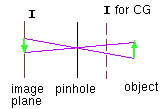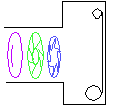Cameras
Reviewing some of the basics of optical imaging systems
helps reveal some of the implicit assumptions often made in producing
images with computer graphics.
Ideal pinhole camera

Real pinhole camera

Aperture with a lens system

Why is depth-of-field limited?

Camera Elements

The 'aperture' of a lens is the diameter of the lens opening
divided by the focal length of the lens. For a typical 50mm lens,
the aperture may range from f/2 (large aperture) to f/22 (small aperture).
The aperture will determine the depth of field of the resulting image.





